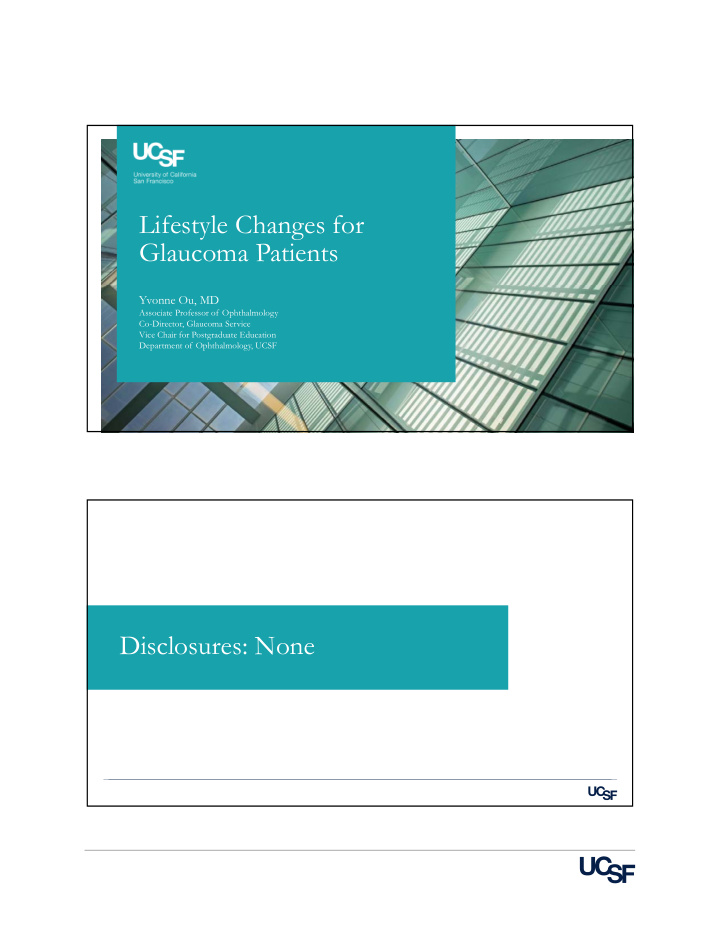



Lifestyle Changes for Glaucoma Patients Yvonne Ou, MD Associate Professor of Ophthalmology Co-Director, Glaucoma Service Vice Chair for Postgraduate Education Department of Ophthalmology, UCSF Disclosures: None
“ “Doctor, what else can I do to help my glaucoma?” Where are we on the pyramid?
Lifestyle modifications in glaucoma Start exercising Keep yoga upright Sleep habits Don’t overcaffeinate Eat your veggies Avoid overtreating hypertension
141 patients, avg age 65, 57% female Mean baseline MD -6.6 dB Average of 6.7 days of physical activity measurement, average of 5613 steps per day, 148 min/day of nonsedentary activity, 11 min/day of moderate-to-vigorous physical activity Ophthalmology 2019;126:958-964.
“ “Each incremental increase of 1000 steps per day was associated with less sensitivity loss over time (+0.007 dB/year, P < 0.001) . Each additional 30 minutes of nonsedentary activity and each 10 minutes of moderate to vigorous activity also associated with less VF sensitivity loss over time.” Ophthalmology 2019;126:958-964. Patients with greater VF loss perform less physical activity Ramulu PY et al. Ophthalmology 2012;Jun;119(6): 1159-1166.
JAMA. 2018;320(19):2020-2028 “ “Adults should do at least 150 minutes to 300 minutes a week of moderate-intensity, or 75 minutes to 150 minutes a week of vigorous-intensity aerobic physical activity, or an equivalent combination of moderate- and vigorous-intensity aerobic activity. They should also do muscle-strengthening activities on 2 or more days a week. Older adults should do multicomponent physical activity that includes balance training as well as aerobic and muscle-strengthening activities.”
“ “Recommendations emphasize that moving more and sitting less will benefit nearly everyone. Individuals performing the least physical activity benefit most by even modest increases in moderate-to-vigorous physical activity.” Fact or Fiction? Glaucoma patients should avoid yoga
Jasien JV et al. PLoS ONE 2015; Dec; 10(12): e0144505 Downward dog results in the largest IOP increase in healthy and glaucoma patients Jasien JV et al. PLoS ONE 2015; Dec; 10(12):e0144505.
Fact or Fiction? Sleeping with the head of the bed elevated lowers IOP AJO November 2015, 160(5):929-936.
Lateral decubitus body position results in higher IOP in dependent eyes 2 mmHg higher 2 mmHg lower 2 mmHg higher Optom Vis Sci 2016, 93(9):1163-1170.
Lifestyle modifications in glaucoma Don’t overcaffeinate
Prospective, double-masked, crossover, RCT with 106 subjects Subjects ingested 237 ml of caffeinated or decaffeinated coffee IOP and BP were measured; OPP calculated “Consuming one cup of caffeinated coffee (182 mg caffeine) statistically increases, but likely does not clinically impact, IOP and ocular perfusion pressure in those with or at risk for POAG.”
Lifestyle modifications in glaucoma Eat your veggies Greater intake of dietary nitrate (green leafy vegetables), an exogenous source of NO, was associated with a 20-30% lower POAG risk The effect was greatest (40-50% lower risk) for POAG with early paracentral VF loss at diagnosis, to which vascular dysregulation has been associated JAMA Ophthalmol. Mar 2016;134(3):294-303.
AJO June 2008, 145(6):1081-1089. AJO October 2012, 154(4):635-644. Lifestyle modifications in glaucoma Avoid overtreating hypertension
What does the SPRINT trial mean for our glaucoma patients? The SPRINT Research Group.N Engl J Med 2015; 373:2103-2116. Systolic BP in the standard vs. intensive treatment groups The SPRINT Research Group.N Engl J Med 2015; 373:2103-2116.
Intensive treatment group had a 25% lower relative risk for primary outcome The SPRINT Research Group.N Engl J Med 2015; 373:2103-2116.
Treatment goal for SBP of less than 120 mm Hg reduced incident cardiovascular disease by 33% and total mortality by 32%. The mean diastolic BP in the intensive group was 62 mmHg, 5 mmHg lower than in the standard group. JAMA. 2016;315(24):2673-2682. doi:10.1001/jama.2016.7050 Ophthalmology 2007, 114(11):1965-72.
The duration and magnitude of decrease in nocturnal blood pressure below the daytime MAP, especially pressures that are 10 mmHg lower than daytime MAP, predict NTG progression. Low nocturnal blood pressure, whether occurring spontaneously or as a result of medications, may lead to worsening of VF defects. Ophthalmology 2014, 121:2004-12. What I tell my patients about lifestyle changes Start exercising, esp. if Keep yoga upright, as you aren’t already inverted poses Head of bed elevation transiently increase IOP Work with internist & Eat green leafy veggies Don’t overcaffeinate avoid nocturnal hypotension
Thank you! What I tell my patients about lifestyle modifications Get moving, especially if you aren’t already Inverted head poses transiently increase IOP, but how this truly affects glaucoma progression is unknown Consider sleeping with the head of the bed elevated Eat a variety of fruits and vegetables, especially green, leafy vegetables Drink your daily cup of coffee, but don’t binge (or switch to decaf) What other risk factors for CV disease do you have? If not many, and/or if glaucoma is progressing despite good IOP control, ensure patient is not being over-treated for hypertension
Caffeine inhibits ganglion cell loss in experimental glaucoma Madeira MH et al. Sci Rep. 2016 6:27532.
Recommend
More recommend